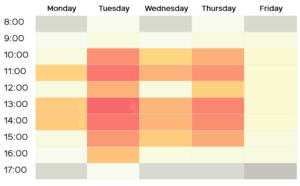Each morning, millions of office workers start their working day. Some with a coffee, some with a short catch-up with their befriended colleagues, some in a start-up call. Across the day, everyone follows their own rhythm. A manager who moves from meeting to meeting, a remote software engineer who works by himself all week, or a project manager who spends her morning in meetings and the afternoon preparing her product. The magnitude of different jobs and different organisations provide a colourful spectrum of activities and schedules. Nevertheless, although there is a wide variety of schedules, we can find an odd symmetrical pattern in our occupancy data that roughly most employees follow across their working day.
Break time
Although there are many different schedules, most of them if not all, take their break time in the early afternoon. From 12 O’clock, canteens and cafeterias start to fill with employees who have their lunch and chat with each other. Although some of them might have a break at their desk, or eat a sandwich in an ill-scheduled meeting, most people take their break halfway through the working day. This moment is usually the moment where most people synchronize and have a shared moment off their work.
Meetings around lunch
According to Measuremen’s data, meeting space occupancy is highest later in the morning between 10:00-12:00 AM, and from 13:00-15:00 PM. This is a time when most employees are at the office and thus are having meetings most efficiently. Another reason could be that having meetings too early or too late might coincide with low energy levels. Therefore, people might prefer to schedule meetings when they are feeling high energy and hope to expect that from their colleagues. It could be questioned though whether the high energy levels of people are effectively utilised with having meetings at those moments. High energy could maybe rather be spent on individual work as joining meetings can be less demanding. Nevertheless, this might differ between meetings and people.

Starting and closing with individual work
The working day starts for many people with individual work. From answering emails to scheduling, to writing reports, to watching short videos. Many employees start the day at their desks. Spending time individually can be enjoyed by employees who don’t like to be bothered, but can be perceived as difficult for people who have issues with getting started.
At the end of the day, most employees also spend their time doing individual work. The afternoons are a perfect time to execute the tasks that were discussed during the meetings and to finish work before going back home.
A meeting-centred workplace
Interestingly, for most people, their individual work is scheduled around their meetings. Since most meetings are scheduled around lunch, the early morning and late afternoon are “leftover” to engage in individual work. Some people schedule “focus time” in their calendar to prioritize this but this is not a common practice and is often overruled when there are meeting scheduling issues. In other words, meetings are prioritized when it comes to office rhythms. People need to schedule their individual work around those meetings.
A symmetric workplace dynamics model
Together, this creates a curious symmetric workplace dynamics model of people moving from space to space, from activity to activity. This model presents a common workplace dynamic that is present in many organisations. Not every employees adheres to this dynamic, as role types and personal eating schedules differ but it’s a rough pattern. The model might also be quite Western European-focused since the majority of the European people are at lunch at 12 o’clock. This lunch pattern is also the basis for the establishment of these workplace dynamics. People and managers like to have lunch together at the same time and synchronize around this time. Almost all people are at the office around lunch, which makes way for the organisation of meetings around lunch. Smaller groups of people synchronize and move to a meeting room together. These meetings are typically scheduled between 10-12 and 13-16 o’clock. The rest of the day, and the moments no meetings are scheduled, is left over for individual work. After that, all the people leave the office and end up at home, from which they enter the next day the office again. It’s curious that such a model can be established, but what does this mean for workplace management?

What does this mean for workplace management?
It’s important to understand the dynamics of the workplace to be aware of the peak occupancy of the different workspaces. Complaints and issues can be expected at specific moments and be of a different nature. Cleaning and other support services can also be effectively scheduled along with the work rhythm. Spaces can also be designed more efficiently if a workplace manager knows the workday rhythm very well. The shift from desks to meeting spaces across the day usually requires a 2-to-1 seat-to-people ratio. This can be optimized by managing spaces with the day rhythms in account. Through strategy and workplace policies one can reduce this ratio and make the space use more effective and people more productive. For example, one could effectively spread the meetings across the day instead of these concentrated peaks. One could also design workspaces to be more activity-ambiguous, requiring fewer spaces in total. For example, meeting spaces that can be used as individual desks in the afternoon will improve utilisation and therefore require less space.
Know your workplace
Although this symmetric pattern seems to be common for many organisations, every workplace is different. Small varieties might influence your space use massively. Before making any important workplace decisions, gather data from your workplace to identify your workplace patterns. Contact us for more information.


